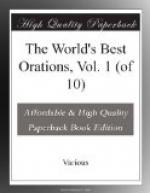But there still remained the last and crowning act, which the people of the Union alone were competent to perform—the institution of civil government, for that compound nation, the United States of America.
At this day it cannot but strike us as extraordinary, that it does not appear to have occurred to any one member of that assembly, which had laid down in terms so clear, so explicit, so unequivocal, the foundation of all just government, in the imprescriptible rights of man, and the transcendent sovereignty of the people, and who in those principles had set forth their only personal vindication from the charges of rebellion against their king, and of treason to their country, that their last crowning act was still to be performed upon the same principles. That is, the institution, by the people of the United States, of a civil government, to guard and protect and defend them all. On the contrary, that same assembly which issued the Declaration of Independence, instead of continuing to act in the name and by the authority of the good people of the United States, had, immediately after the appointment of the committee to prepare the Declaration, appointed another committee, of one member from each colony, to prepare and digest the form of confederation to be entered into between the colonies.
That committee reported on the twelfth of July, eight days after the Declaration of Independence had been issued, a draft of articles of confederation between the colonies. This draft was prepared by John Dickinson, then a delegate from Pennsylvania, who voted against the Declaration of Independence, and never signed it, having been superseded by a new election of delegates from that State, eight days after his draft was reported.
There was thus no congeniality of principle between the Declaration of Independence and the articles of confederation. The foundation of the former was a superintending Providence—the rights of man, and the constituent revolutionary power of the people. That of the latter was the sovereignty of organized power, and the independence of the separate or dis-united States. The fabric of the Declaration and that of the confederation were each consistent with its own foundation, but they could not form one consistent, symmetrical edifice. They were the productions of different minds and of adverse passions; one, ascending for the foundation of human government to the laws of nature and of God, written upon the heart of man; the other, resting upon the basis of human institutions, and prescriptive law, and colonial charter. The corner stone of the one was right, that of the other was power. ...
Where, then, did each State get the sovereignty, freedom, and independence, which the articles of confederation declare it retains?—not from the whole people of the whole Union—not from the Declaration of Independence—not from the people of the State itself. It was assumed by agreement between the legislatures of the several States, and their delegates in Congress, without authority from or consultation of the people at all.




